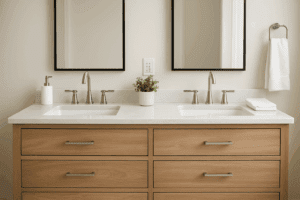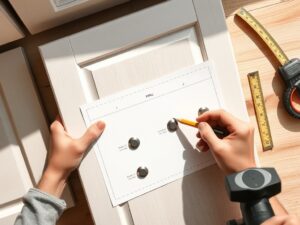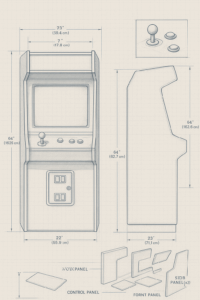When it comes to building cabinets with plywood, you’re choosing one of the most versatile and reliable materials available for woodworking projects. Whether you’re crafting kitchen cabinets, bathroom vanities, storage units, or specialty cabinets like arcade units, plywood offers distinct advantages that make it the preferred choice for both professional cabinet makers and DIY enthusiasts.
Why Plywood Reigns Supreme for Cabinet Construction
Exceptional Strength and Stability
Plywood’s cross-grain construction creates a material that’s significantly stronger than solid wood in many applications. The alternating grain directions in each layer prevent the warping, splitting, and expansion issues that plague solid wood cabinets. This means your cabinets will maintain their shape and function for decades, even in environments with fluctuating humidity levels like kitchens and bathrooms.
The structural integrity of plywood allows you to build larger cabinet spans without the sagging that occurs with particleboard or MDF. A plywood shelf can comfortably support heavy items like dishes, books, or equipment without bowing over time.
Superior Screw Holding Power
One of the most practical advantages when building cabinets with plywood is its excellent screw retention. Unlike particleboard, which can crumble around screws, or MDF, which requires special fasteners, plywood grips screws securely across its entire thickness. This means stronger joints, more reliable hardware mounting, and cabinets that won’t fall apart under normal use.
The multiple wood layers provide plenty of material for threads to bite into, making it ideal for mounting hinges, drawer slides, and other cabinet hardware that needs to withstand repeated stress.
Moisture Resistance Options
While solid wood can warp and crack when exposed to moisture, plywood offers various grades specifically designed for humid environments. Marine-grade plywood uses waterproof glues that won’t delaminate, making it perfect for bathroom vanities or outdoor storage cabinets. Even standard interior plywood handles moisture changes better than many alternatives.
Cost-Effective Without Sacrificing Quality
Compared to solid hardwood, plywood delivers exceptional value. You get the strength and workability of wood at a fraction of the cost of solid lumber. High-quality plywood sheets also provide consistent thickness and fewer defects than solid wood boards, reducing waste and ensuring predictable results.
Essential Plywood Types for Cabinet Building
Cabinet-Grade Plywood
When building cabinets with plywood, cabinet-grade varieties offer the best combination of appearance and performance. These typically feature hardwood face veneers like oak, maple, or birch over a solid wood or composite core. The smooth, defect-free surfaces are perfect for staining or painting.
Baltic Birch Plywood
This premium option features solid birch throughout all layers, creating an incredibly strong and stable material. The attractive edge grain means you can leave edges exposed for a modern, clean look. Baltic birch is particularly popular for contemporary cabinet designs and high-end built-ins.
Apple Ply and Other Hardwood-Faced Options
For those seeking the appearance of solid hardwood, these plywoods feature thick hardwood face veneers that can be sanded and finished just like solid wood. They’re perfect when you want the look of expensive hardwood without the cost or stability issues.
Planning Your Plywood Cabinet Project
Calculating Material Needs
Plywood comes in standard 4×8 foot sheets, so efficient planning is crucial for minimizing waste. Start by creating a cut list that maximizes the use of each sheet. Consider the grain direction for visible surfaces and plan your cuts to maintain consistent grain patterns across cabinet faces.
For most cabinet projects, you’ll need different thicknesses. Three-quarter inch plywood works well for cabinet sides, shelves, and face frames, while half-inch material is suitable for backs and internal components. Quarter-inch plywood serves well for cabinet backs in lighter applications.
Essential Tools for Plywood Cabinet Construction
Building cabinets with plywood requires specific tools to handle the material’s characteristics. A quality table saw or track saw is essential for making straight, clean cuts. Plywood tends to chip on the bottom face, so use a fine-toothed blade and consider scoring cut lines with a utility knife.
A router helps create professional-looking edges and joinery. Pocket hole jigs are particularly useful for plywood construction, creating strong joints that are completely hidden. Don’t forget clamps – lots of them – as plywood construction often requires holding multiple pieces while glue sets.
Joinery Techniques That Work Best with Plywood
Dadoes and Rabbets
These traditional joints work exceptionally well with plywood. Dadoes (grooves cut across the grain) provide excellent support for shelves, while rabbets (L-shaped cuts along edges) create strong corner joints. The multiple layers in plywood actually strengthen these joints compared to solid wood.
Pocket Holes
This modern joinery method is perfect for plywood cabinet construction. The screws pull pieces tightly together while remaining completely hidden. Pocket holes work especially well for face frames and internal cabinet assembly.
Biscuit Joints
For edge-to-edge connections, biscuit joints provide excellent alignment and strength. They’re particularly useful when joining plywood panels for wider surfaces or creating seamless face frames.
Finishing Plywood Cabinets for Professional Results
Surface Preparation
The key to professional-looking plywood cabinets lies in proper surface preparation. Start with 120-grit sandpaper to level any imperfections, then progress to 150 and 220 grit for smooth surfaces. Pay special attention to edges, which may need filling if you’re painting.
Edge Treatment Options
Plywood edges show the layered construction, which may not suit every design. Iron-on edge banding provides a quick solution that matches the face veneer. For painted cabinets, consider solid wood strips that can be shaped and detailed to match your design vision.
Staining and Painting Considerations
High-quality plywood takes stain beautifully, often more evenly than solid wood due to its consistent grain pattern. For painted finishes, the smooth surface of cabinet-grade plywood requires minimal preparation, unlike the texture issues you might face with other materials.
Common Challenges and Solutions
Preventing Tear-Out
Plywood can chip and tear during cutting, especially when using circular saws. Combat this by using sharp, fine-toothed blades, supporting the material properly, and making test cuts on scraps to verify your setup.
Dealing with Voids
Occasionally, interior voids in plywood layers become visible at cut edges. Fill these with wood filler before finishing, or plan cuts to minimize exposed edges in visible areas.
Managing Weight
While plywood is lighter than solid wood of equivalent thickness, large cabinets can still be heavy. Plan for adequate support during installation and consider breaking large units into manageable sections.
Cost Considerations and Budgeting
Material Costs
Building cabinets with plywood typically costs 30-50% less than solid hardwood construction while delivering comparable durability. Budget approximately $40-80 per sheet for cabinet-grade plywood, depending on species and quality level.
Tool Investment
The tools needed for plywood construction are generally less specialized than those required for advanced solid wood joinery. A basic shop setup with a table saw, router, and quality drill can produce professional results.
Time Savings
Plywood’s dimensional stability and consistent thickness can significantly reduce construction time compared to working with solid lumber that requires extensive milling and preparation.
Project Ideas Perfect for Plywood Construction
Kitchen Cabinets
Plywood’s strength and moisture resistance make it ideal for kitchen applications. The material easily supports heavy dishes and appliances while standing up to the humidity and temperature changes common in kitchens.
Built-in Storage Solutions
From bedroom closets to home office built-ins, plywood provides the structural integrity needed for large, spanning storage systems. Its consistent dimensions make it easy to create modular systems that can adapt to different spaces.
Workshop and Garage Cabinets
The durability and strength of plywood shine in utility applications. These cabinets need to hold heavy tools and equipment while withstanding less-than-ideal environmental conditions.
Entertainment Centers and Media Cabinets
Modern electronics require cabinets that can support significant weight while providing clean cable management. Plywood’s workability makes it easy to create custom cutouts and routing for cables while maintaining structural integrity.
Professional Tips for Success
Grain Matching
When building cabinets with plywood, pay attention to grain direction and pattern matching across visible surfaces. Book-matching adjacent panels creates a more refined, professional appearance.
Hardware Considerations
Plywood’s excellent screw-holding ability allows for a wide range of hardware options. However, consider the thickness of your material when selecting hinges and drawer slides to ensure proper function.
Seasonal Movement
While plywood moves less than solid wood, it still expands and contracts with humidity changes. Allow for this movement in your design, particularly in long spans or when combining plywood with other materials.
Building cabinets with plywood offers the perfect balance of strength, workability, and economy. Whether you’re a beginner looking to build your first cabinets or an experienced woodworker seeking efficient construction methods, plywood provides the foundation for successful projects that will serve you well for years to come. The material’s forgiving nature, combined with its professional results, makes it the smart choice for cabinet construction in any setting.
This article contains affiliate links, which means we may earn a small commission at no extra cost to you if you click through and make a purchase.


